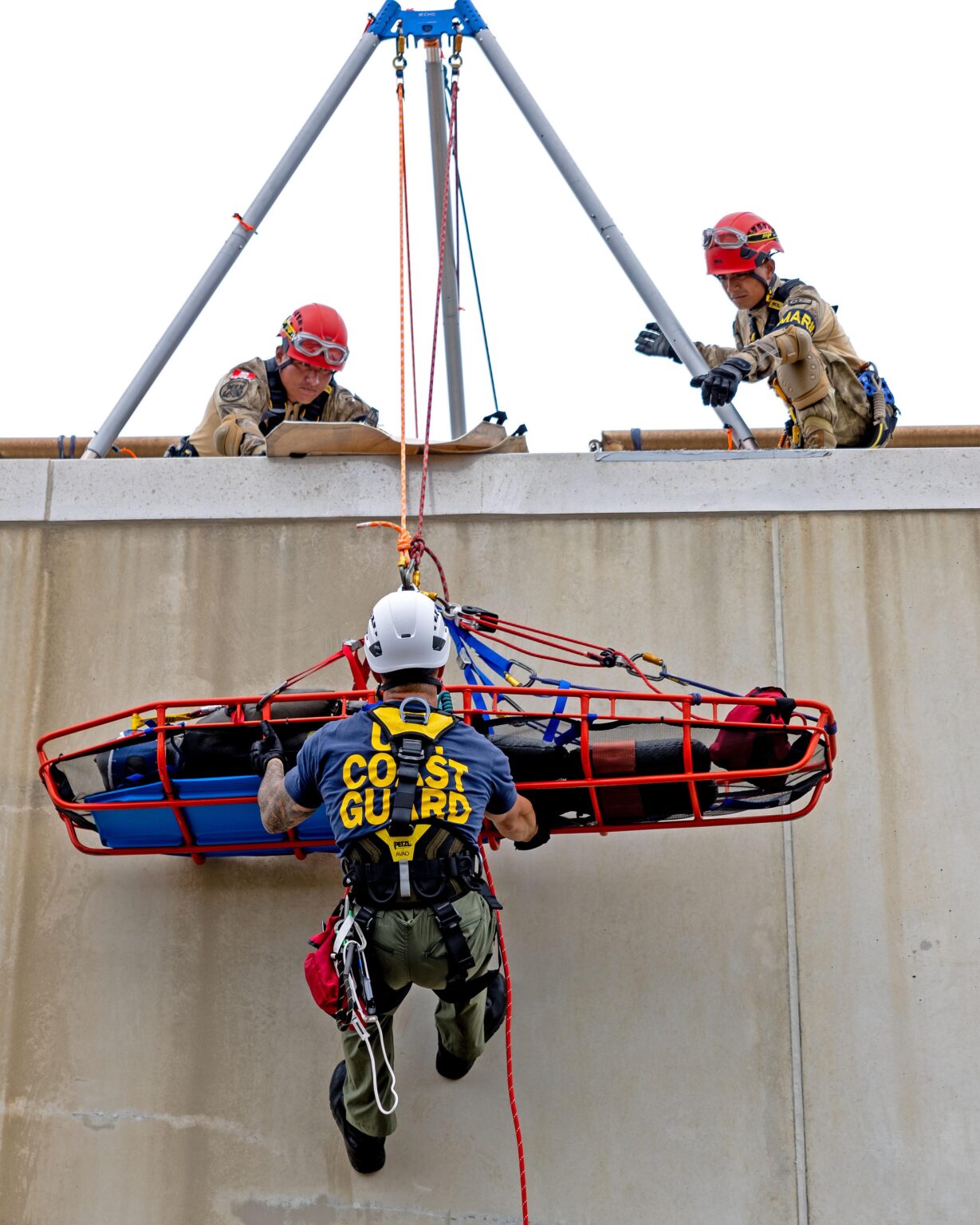Mexican Sailors, Peruvian Naval Infantry Soldiers and U.S Coast Guard personnel conducted the first urban search and rescue operation in the 53-year-history of Exercise Rim of the Pacific. SPEC. 1ST CLASS TYRELL K. MORRIS/U.S. NAVY
THE WATCH STAFF
Mexican Sailors, Peruvian Naval Infantry Soldiers and U.S. Coast Guardsmen completed the first urban search and rescue (USAR) exercise in the 53-year history of the Rim of the Pacific (RIMPAC) exercise in July 2024, which showcased the increasing interoperability of the U.S. and its partners. The training also provided valuable preparation for the rescue of civilians from natural disasters, an increasing threat around the world.
Coastal communities especially are at risk for wind and water surges from hurricanes, typhoons, flooding and tsunamis. Destructive surges and gusts can trap people in those communities in attics or rooftops. The three-day exercise in Hawaii included members from the Coast Guard’s Pacific Strike Team along with their Peruvian and Mexican counterparts. The forces combined training, simulated search and rescue (SAR) coordination and survivor extraction and triage, according to a U.S. Navy news release. The SAR operation formed part of the humanitarian and disaster response component of RIMPAC 24.
The Mexican and Peruvian teams are experienced at rescuing survivors from damaged structures. The Coast Guard team contributed tactics for water-based rescues. The Coast Guard also shared its system of detecting and identifying hazardous materials, the release stated. “Natural disasters present serious rescue challenges in urban areas, so we were all grateful for the chance to share our experiences and tactics that have saved hundreds of lives during recent storms and flooding events around the United States,” said Chief Warrant Officer Ian Thompson, the Urban Search and Rescue coordinator for the Pacific Strike Team. “All three teams leave this collaboration with a greater capability to collaborate and to save lives after disasters in our home countries and abroad.”
The simulation included teams driving inflatable boats into a flooded community and cutting through a roof. On the nearby Marine Corps Base Hawaii, the teams practiced moving injured people up and out of buildings using ropes, pulleys and tripods. The teams also entered confined spaces affected by water or other atmospheric challenges to rescue victims, the release stated. Technological innovation also yielded future benefits as a Federal Emergency Management Agency’s Geographic Information Systems’ (SARCOP) smartphone app successfully connected the teams with rescue coordinators through a common operating picture. All three countries now can coordinate through SARCOP, a capability “which will streamline coordination in future search and rescue operations.”
This seamless integration could save crucial minutes or hours in a rescue operation. “Participating in these exercises has been invaluable for our teams,” said Lt. j.g. Gonzalo Hernandez of the Peruvian Naval Infantry, according to the Navy release. “We have not only improved our technical skills but also strengthened our ability to work alongside our international partners. The use of the SARCOP app has significantly enhanced our coordination capabilities, which will enhance our collective response to natural disasters.” The Mexican Navy will also benefit from the collaboration, said Mexican Navy Seaman Lizeth Magaña. “Working with the U.S. Coast Guard and Peruvian Navy is really good for us. We can learn a lot of their techniques and share how we work in Mexico,” she said. “We are so grateful for this partnership opportunity in RIMPAC.”
The Pacific Strike Team, based in Novato, California, provides an expert deployable force for search and rescue operations, pollution and hazardous material spills, and recovering from weapons of mass destruction events, according to the release. The team has conducted SAR missions after hurricanes Harvey, Katrina and Ian. Its growth has been a decade-long endeavor as the Coast Guard has enhanced its flood response capabilities to deliver Catastrophic Incident Search and Rescue. All USAR teams across the Coast Guard and other service branches have received the enhanced training and mobile response equipment, the release stated.
“We are honored to have participated in such a comprehensive exercise,” said Peru’s Lt. Hernandez. “The shared experiences and knowledge gained here are invaluable, and we look forward to applying these lessons to improve our disaster response capabilities.”
RIMPAC 24 involved 29 nations, 40 surface ships, three submarines, 14 national land forces, more than 150 aircraft and 25,000 personnel in and around Hawaii from June 27 to August 1, 2024. The exercise dates to 1971.

